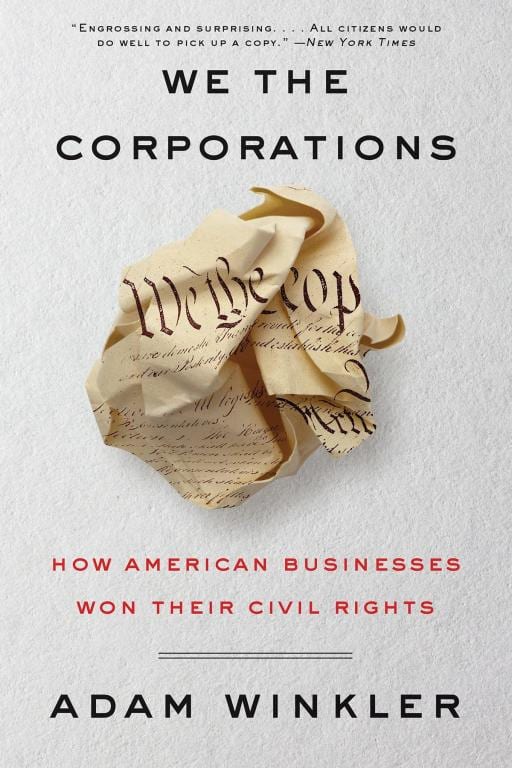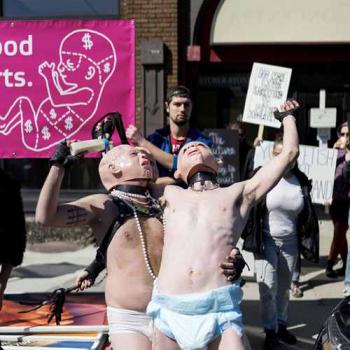Adam Winkler (1967-) is a professor of constitutional law at UCLA. I first encountered him through his fascinating book Gunfight: The Battle over the Right to Bear Arms in America. So I was intrigued when I discovered he published a second book on We the Corporations: How American Businesses Won Their Civil Rights.
 I’ve posted previously about Winkler’s first book, so I’ll limit myself to only one point from it for now. In the 2008 case District of Columbia v. Heller the Supreme Court ruled—for the first time in U.S. history—that the Second Amendment protects an individual’s right to possess a firearm for self-defense. Previous cases, in contrast, were closer to the militia theory of the Second Amendment. In the latter line of thinking, if you want to exercise your Second Amendment rights, you should enlist in the National Guard, which is the contemporary equivalent of our founders’ “well-regulated militia.”
I’ve posted previously about Winkler’s first book, so I’ll limit myself to only one point from it for now. In the 2008 case District of Columbia v. Heller the Supreme Court ruled—for the first time in U.S. history—that the Second Amendment protects an individual’s right to possess a firearm for self-defense. Previous cases, in contrast, were closer to the militia theory of the Second Amendment. In the latter line of thinking, if you want to exercise your Second Amendment rights, you should enlist in the National Guard, which is the contemporary equivalent of our founders’ “well-regulated militia.”
Whether you agree or disagree with that logic, the more important point is that District of Columbia v. Heller was a 5-4 split decision in which the justices were divided along their personal ideological lines. And I’m interested in the ways that this ideologically-split decision exposes the ways that judicial interpretation is as much about exercising power as it is about carefully, judiciously discerning what words and sentences “really mean.”
Along these lines, the late William Brennan (1906-1997), a long-serving Associate Justice of the U.S. Supreme Court, used to ask his new law clerks, “What is the most important rule of constitutional law?” After watching them fumble for answers, he would hold up one hand with his fingers outstretched: ‘Five,’ he would say; ‘You need five votes to make a majority on the nine-member Court (Gunfight, 273). Five votes means that that side’s interpretation is the law of the land—even though it won by a mere one vote against the strong dissent of four equally smart justices.
In 2010, two years after that second amendment ruling, the U.S. Supreme Court case Citizens United v. Federal Election Commission was also a 5-4 decision, likewise split along ideological lines. In my own view and that of many other court watchers, this decision was neither the desirable nor correct outcome, but it is for now the law of the land. And as with Gunfight on the Second Amendment, Winkler is a helpful guide to understanding how we have reached this point.
When I think about cases like Citizens United, I sometimes feel like I’m in a theater at the beginning of a dystopian film—and words appear to set the context for how the world has become so messed up: In 2010, the United States Supreme Court approved corporations’ “First Amendment right to spend their money to influence elections.” And that was the beginning of how “We the People” became the barbarians at the gate of our Corporate Overlords.
Hopefully we will turn the ship around before we reach quite so extreme a point, but to figure out how we got to our already dire present situation, let’s take a brief tour back to the early days of our nation. The famous preamble to the Constitution begins with the ringing words, “We the People of the United States….” But who is the “we” in “We the People?”
Indeed, one common suggestion for small group conversations? and interpersonal conflict mediations is to use “I-statements” instead of “you” or “we” language. In such situations, you are generally on much safer ground speaking for yourself than trying to speak for someone else.
Back in 1789, our nation’s founders “used the phrase We the People to identify who was responsible for enacting this charter of liberty and self-government…but more than half the nation’s population was prohibited from participating in the process by which the Constitution was adopted; most were also denied many of the rights the Constitution purported to guarantee” (xv). We need to be honest that in the Eighteenth Century, neither enslaved African-Americans, nor women (who were denied the right to vote) were included in “We the People”.
The twist is, of course, that “We the People” came to serve as a rallying cry for widening the circle of who is included in “We the People.” And many of us have studied the struggle for Civil Rights, Women’s Suffrage, Labor Rights, LGBTAIQ rights, Disability Rights, and more. Winkler’s book helped call my attention this past year to the parallel history of rights for corporations.
It turns out that:
The Constitution of the United States went into effect in 1789, but it took nearly seventy years before the Supreme Court heard its first case explicitly addressing the constitutional rights of African Americans, in Dred Scott v. Sandford, in 1857. The court in that case held that African Americans had “no rights which the white man was bound to respect.”
The first women’s rights case, Bradwell v. Illinois, on whether women had a right to practice law, was not heard until 1873, and the Supreme Court ruled against the woman.
Conversely, the first corporate rights case in the Supreme Court was decided decades earlier, in 1809, and the corporation won. (35)
Corporations have been early, active, and highly successful advocates for their constitutional rights in the United States.
On the one hand, the success of corporations in securing constitutional rights could be viewed as surprising. If you search the text of the Constitution, you will not find even one mention of the word “corporation.” Corporations were also not a major topic at the Constitutional Convention:
When the Founders met in Philadelphia in the summer of 1787, the only discussion of corporations was a proposal by James Madison to give Congress the power to charter them, which was ultimately defeated. Corporations and their place in the constitutional structure were not debated in the state conventions that ratified the Constitution, nor mentioned in the famed Federalist Papers…. As best we can tell, the people who wrote and ratified the Constitutions simply never considered whether the Constitution applied to corporations. (3)
On the other hand, powerful corporate influence has been with us since the beginning of this country. Those settlers at Plymouth were funded by the Virginia Company, the Massachusetts Bay Company was a major early influence on the colonies, and our Independence Day was sparked by a rebellion against an unfair tax favoring the East India Company (31).
But despite the absence of the word ”corporation” in the Constitution, corporate rights advocates have been stunningly successful in winning Supreme Court cases in their favor (xviii):
Indeed, today, corporations have nearly all the same rights as individuals: freedom of speech, freedom of the press, religious liberty, due process, equal protection, freedom from unreasonable searches and seizures, the right to counsel, the right against double jeopardy, and the right to trial by jury, among others. Corporations do not have every right guaranteed by the Constitution; they have no right to vote or right against self-incrimination, and none to date has gone to court asserting a right to keep and bear arms. (xvi)
Since Citizens United, corporations also have a “First Amendment right to spend their money to influence elections.” And for a confluence of reasons, this landmark in the “Corporate Rights Movement” has caused more outrage than the many previous decisions along these same lines.
In the wake of Citizens United, the slogan that has most captured the public’s imagination is that, “Corporations are NOT People” (xvi). Now, from a legal perspective, it’s more complicated than that. But I do think that protest slogan begins to get to the heart of the matter: that our priorities have gotten out of place. Regardless of how we legally define corporations, actual human beings are ultimately more important.
One touchstone that has become increasingly important to me in building the world we dream about is the “Triple Bottom Line” of People, Planet, and Profit. Profit motive—including corporate profits—will always be a major factor, but instead of holding profit for stockholders as the only “bottom line,” financial gain should be better balanced with people (labor rights) and planet (environmental sustainability). You might even say we need a #GreenNewDeal, but I’ll set that aside for now to explore more fully in the future.
For now, as I have learned more about the history of the corporate rights movement, I’ve come to see that it’s messier than I expected. One of the biggest surprises concerns Roger Taney (1777-1864), the fifth Chief Justice of the Supreme Court, who is literally buried on the same block where I live downtown in Frederick, Maryland. (His bust was finally removed from in front of Frederick City Hall in March of last year.) In the lead-up to the Civil War, Taney is remembered for writing the majority opinion in the 1857 case of Dred Scott v. Sandford, which ruled against the Constitutional rights and citizenship of anyone whose ancestors had been enslaved. This ruling is almost universally regarded as the single most reprehensible decision ever made by the U.S. Supreme Court.
Taney was very much on the wrong side of history in Dred Scott (xix). But I was interested to learn that he was also “one of the most forceful advocates for limiting the constitutional rights of corporations” (xix). And let me add two more twists of irony to this story. First, “It was the famously liberal New Deal and Warren courts of the mid-twentieth century that first extended personal liberty rights to corporations” (xx). And second, even though it is infuriating that corporate rights were often secured decades before those same rights were secured for other groups of “We the People,” it turns out that those early corporate rights cases frequently set precedents that were crucial in helping various identity groups eventually secure their constitutional rights (xxiii – xxiv). So, as with many things, as you dive into the details, lines behind to blur and the truth gets more nuanced.
And if you will permit me to indulge in a bit more legal nerdery, it was also during that mid-nineteenth century Taney Court (1336-1864) that the whole “Corporations are NOT People” protest gets flipped upon its head. It is true that the Taney Court was the first Supreme Court to affirm “corporate personhood,” but they did so in order to to limit the rights of corporations. They defined corporate personhood “as an independent legal entity with rights and responsibilities distinct from those of the people who form it.” In contrast, what happened with both Citizens United and the more recent Hobby Lobby case is that corporations were treated not as separate persons, but rather as entities entitled to the rights of the human beings who formed them (74).
If you read Citizens United closely, the text never says, “Corporations are people.” Legally, the whole idea of corporate personhood leads back to Taney treating corporations as an “independent legal entity with rights and responsibilities distinct from those of the people who form it” in order to limit corporate rights. The logic of Citizens United relies on a separate stream of legal precedents interested in “piercing the corporate veil” —that is, focusing on the rights of the human beings behind the corporation (364).
If trying to untie all these legal tangles makes you understandably feel a little topsy turvy, let me give one more example. The more recent 2014 Supreme Court decision Burwell v. Hobby Lobby also did not claim that “corporations are people.” Instead, the Supreme Court again chose to “pierce the corporate veil” and look to the personal liberties of David Green, the human being who owns the company Hobby Lobby. From the perspective of the majority opinion: “Hobby Lobby was the Greens, and the Greens were Hobby Lobby.” Thus, it was unconstitutional to impinge on the religious liberty of the Greens in order to force them to provide contraceptive health insurance coverage for their female employees (379-381.)
So ironically, the whole protest of “Corporations are NOT people” can be viewed as wrongheaded from a legal perspective. Rather, corporate personhood—not acknowledging the corporate veil—has more regularly been the way courts limit corporate rights in the history of American jurisprudence.
That being said, in insisting the “corporations are NOT People,” protesters are on to something. The reason so many people respond so positively and viscerally to “Corporations are NOT People” is our deep sense that our national—and really, our global—priorities are so out of whack. Corporate profit has for too long been given primacy over the interests of workers and the environment. At the heart of the claim “Corporations at Not People” is the truth that “people are more important than corporations”—and human rights are more important than corporate rights.
But here’s the thing: it is not enough to be on the side of the human and the humane. Citizens United was a 5-4 decision. Hobby Lobby was a 5-4 decision. Remember Justice Brennan’s question, “What is the most important rule of constitutional law?” Five: You need five votes to make a majority on the nine-member Court.
And although one truth of U.S. history is that it has been the story of expanding rights for corporations, that is not the only story—and it does not have to be the final story. In the words of the late American Pragmatist philosopher Richard Rorty, we can learn to better tell our story as one of an increasingly inclusive understanding of “We the People”—to experience ourselves as:
proud and loyal citizens of a country that,
slowly and painfully, threw off a foreign yoke,
freed its slaves,
enfranchised its women,
restrained its robber barons and licensed its trade unions,
liberalized its religious practices,
broadened its…moral tolerance, and
built colleges in which [increasing percentages] of its population could enroll.
A country that numbered Jefferson, Thoreau, Susan B. Anthony, Eugene Debs…Rosa Parks, and James Baldwin among its citizens (121-122)
We the people can and must demand a better and more inclusive story for ourselves, for our children, for this earth, and for generations to come. Together we can build a world of peace, liberty, and justice—not merely for some—but for all.
The Rev. Dr. Carl Gregg is a certified spiritual director, a D.Min. graduate of San Francisco Theological Seminary, and the minister of the Unitarian Universalist Congregation of Frederick, Maryland. Follow him on Facebook (facebook.com/carlgregg) and Twitter (@carlgregg).
Learn more about Unitarian Universalism: http://www.uua.org/beliefs/principles
















